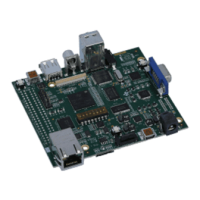Hibernation Module
Prototype:
uint32_t
ROM_HibernateIsActive(void)
ROM Location:
ROM_APITABLE is an array of pointers located at 0x0100.0010.
ROM_HIBERNATETABLE is an array of pointers located at ROM_APITABLE[19].
ROM_HibernateIsActive is a function pointer located at ROM_HIBERNATETABLE[24].
Description:
This function queries the control register to determine if the module is already active. This
function can be called at a power-on reset to help determine if the reset is due to a wake from
hibernation or a cold start. If the Hibernation module is already active, then it does not need to
be re-enabled and its status can be queried immediately.
The software application should also use the ROM_HibernateIntStatus() function to read the
raw interrupt status to determine the cause of the wake. The ROM_HibernateDataGet() func-
tion can be used to restore state. These combinations of functions can be used by the software
to determine if the processor is waking from hibernation and the appropriate action to take as
a result.
Returns:
Returns true if the module is already active, and false if not.
11.2.1.13 ROM_HibernateLowBatGet
Gets the currently configured low battery detection behavior.
Prototype:
uint32_t
ROM_HibernateLowBatGet(void)
ROM Location:
ROM_APITABLE is an array of pointers located at 0x0100.0010.
ROM_HIBERNATETABLE is an array of pointers located at ROM_APITABLE[19].
ROM_HibernateLowBatGet is a function pointer located at ROM_HIBERNATETABLE[9].
Description:
Returns a value representing the currently configured low battery detection behavior. The
return value is one of the following:
HIBERNATE_LOW_BAT_DETECT - detect a low battery condition.
HIBERNATE_LOW_BAT_ABORT - detect a low battery condition, and abort hibernation
if low battery is detected.
Returns:
Returns a value indicating the configured low battery detection.
11.2.1.14 ROM_HibernateLowBatSet
Configures the low battery detection.
April 8, 2013 115

